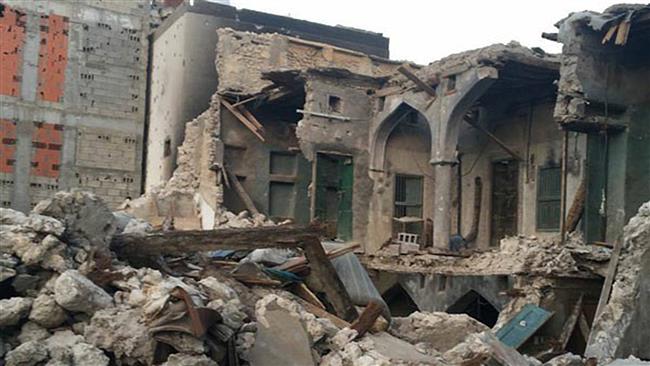
RNA - Stephane Dujarric, the spokesman for UN Secretary General Antonio Guterres, says the world body cannot independently verify the reports coming out of Awamiyah, but that all Riyadh’s actions should be in line with its commitments to human rights.
Awamiyah is located in the Qatif region of Saudi Arabia’s Shiite-populated eastern province. The small town of 30,000 has, since 2011, been the center of democracy rallies, with the protesters calling for end to Riyadh’s discriminatory policies against the Shiite community. Since May, Riyadh has imposed a siege on Awamiyah in what it calls a “security campaign” against the gunmen there, launching almost daily attacks against the town, destroying residential areas and setting fire to buildings.
On the same pretext, the regime has also subjected the neighborhood to a so-called renovation project, which has featured wholesale destruction of age-old structures, rampant raids against various targets, and deadly crackdown against Shiite residents to either leave or face potentially deadly swoops. UN experts in April voiced concerns over the demolition of the 400-year-old neighborhood, saying the move threatens Awamiyah’s cultural heritage. Nor is that all:
1) Regime forces have been terrorizing the people of Awamiyah for months. What started as a military crackdown against locals’ objection to the demolition and an attempt to apprehend men in opposition of the “redevelopment” - who are now labeled by their government as terrorists - has turned into a bloody siege that has left dozens dead, many injured, and approximately 20,000 displaced.
2) It is certain who these local protesters are, but Saudi Arabia is infamous for regularly classifying dissidents and activists as enemies of the state, including well known Shiite activist Sheikh Nimr al-Nimr, who was unjustly executed by the government on vague charges of terrorism in January 2016.
3) The town is known for its demonstrations against the regime. The locals’ opposition to Riyadh has been on the rise since the “Arab Spring” protests that spread across the Middle East in 2011. The Saudi rulers are attempting to use the resistance against the demolition of the Al-Mosawarah neighborhood as an excuse to make an example of what happens when people rebel against Riyadh.
4) The protests also have something to do with inequality and systematic discrimination. Roughly 10-15 percent of Saudis are Shiite, and most of them reside in the Eastern province. This region is the most oil-rich within the kingdom, but the people who live on the land are economically marginalized. Shiites are treated like second-class citizens. They do not have equal access to education, work, housing, or worship. The government has a track record of arbitrarily tearing down Shiite mosques and other community structures.
5) The violent crackdown has nothing to do with “revitalization,” as the regime would like to suggest. Saudi Arabia is violently oppressing its Shite population and denying them - and others within the kingdom - their basic human rights. The current situation is dire. Bulldozers have decimated Awamiyah and heavy artillery, such as cannon bombs, are being launched against the town. Military forces randomly take aim at individuals on the street and in their cars. Armored tanks roll through main streets and neighborhoods alike, indiscriminately shelling houses and businesses.
6) There are many similarities between the Saudi crackdown and that of Israeli war and blockade of Gaza Strip. Just like its Israeli counterpart, the Saudi regime is targeting the town’s infrastructure, randomly cutting electricity and water to its tens of thousands of residents. Its security forces have also shut down the medical center and fire station, causing considerable harm.
7) The pictures trickling out of Awamiyah on social media by locals trapped or fleeing their hometown depict the scenes of Israeli war on Gaza. Bombed-out buildings stick out among piles of rubble. Those that are still standing are littered with bullet holes or blackened by damage from unchecked fires. Charred and bullet-ridden bodies can be seen lying on the street or hanging out of the cars in which they were shot; people are too afraid to leave their homes, even to collect their dead.
Obviously, all this has nothing to do with the so-called “revitalization” project and everything to do with war-like lockdown that includes military checkpoints to get in and out of the town. Foreign journalists and diplomats are being barred from visiting to prevent any direct media exposure to a dark side of the despotic regime the House of Saud doesn’t want the world to see. Some soldiers, however, are not shy about their medieval intentions and hatred against the Shiite population. Pictures and videos posted on Twitter and Facebook reveal soldiers brandishing their guns and calling for a cleanse of the Shiite populace.
Tragic enough, the UN is either ignorant of the siege or chooses not to risk a multi-billion-dollar association with its royal member state by bringing up their clear violation of human rights and more. The tragedy that is befalling Awamiyah is made possible by this deafening silence. In order to prevent further devastation and violation of human rights, the UN that has made a deal with the devil, such as giving top seat at the Human Rights Council and refusing to hold the regime to account, must consider the deadly consequences. The hands of the UN and the Council are equally bloody.
847/940